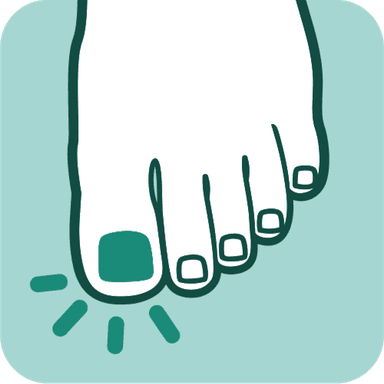Ingrown nail
What is an ingrown nail
When your nail is growing inwards (pseudo unguis incarnatus), the side of the nail presses into the skin. This can cause a lot of pain. The surrounding skin may be red or swollen, although there is no inflammation yet. Once you have an ingrown nail (unguis incarnatus), the tip of the nail is growing into the nail bed. An ingrown toenail does show inflammation symptoms, causing pain and irritation. The nail can create a small wound, which can get infected, causing pus to come out of the skin. An ingrown nail most commonly occurs on the big toe. However, other nails can also grow in. The most prevalent causes are the shape of the nail, cutting away the corners of the nails, picking at the nail, a moist skin (this is especially common among teenagers), shoes that are too narrow or a deviating position of the toe.
Description of a nail growing in
If your nail is growing in, the nail presses into your skin. The nail fold (skin that surround the edges and root of the nail) can start to hurt. The nail wall (the skin edge around the nail plate) may swell and redden. Any pressure – even the pressure of bedsheets on your feet – can hurt. A nail can start growing in because of excess corneum (the ‘horny layer’ of skin) or callus in your nail wall. A round nail can also put increased pressure into the skin.
While the nail is growing in, there is no inflammation. However, the experienced pain may be just as severe. A nail growing in can easily be treated by a professional pedicure or medical pedicure by ProVoet. We advise you not to wait too long once the nail starts to hurt. An untreated nail that is growing in may become infected and become an ingrown nail.
Description ingrown nail
An ingrown toenail grows into the skin. The tip of the nail penetrates the skin and can become infected. The nail wall may turn red and you experience pain under the nail/in your toe. Pus may exit the skin and the nail wall may thicken due to excess cell division. We strongly discourage you from treating an ingrown nail yourself. The longer an ingrown toenail remains untreated, the more intrusive treatment becomes. We advise you to quickly visit a pedicurist or medical pedicurist affiliated with ProVoet.
Symptoms of an ingrown nail
Causes of an ingrown nail
Other foot issues, such as nail fungus, can also cause an ingrown toenail. Do you suffer from nail fungus? Please see our topic: Nail fungus.
Treating an ingrown nail yourself
You cannot treat an ingrown nail yourself. However, you can try to prevent it from growing in. Always cut your nails straight and not too short. Do not cut away any corners. Wear shoes with sufficient room for your toes, both in width and in height. Do your toenails tend to curl inside on the edges? Please consult a pedicurist or medical pedicurist for advice on how to regulate nail growth. Do not attempt to remove an ingrown toenail yourself. This can be very painful and may worsen instead of heal your foot issue. Also do not take foot baths with Biotex or salt. Foot baths soften the skin, making it more vulnerable to infections. To inhibit the infection, we advise following the steps below.
Rinse the affected toe three times a day with a showerhead and lukewarm water. Use a soft massage mode if possible Dab the toe and nail dry using a soft towel. Avoid drying roughly and never use a hairdryer Put colourless disinfectant drops on the nail During the day, tape the nail with a skin-friendly bandage At night, let the nail air dry. Optionally, you can apply medicinal honey salve on the inflamed area (available at the pharmacy)Following these steps should heal the infection in 3-5 days. If the infection does not go away, please contact your general practitioner.
Treatment for ingrown nails
For a nail that is growing in, you can immediately schedule an appointment with the pedicurist or medical pedicurist. They can prevent your nail from growing in further by guiding the growth direction. They can also advise you on how to prevent your nails from growing in in the future. If you have an ingrown nail with an infection, you will need a referral from your general practitioner. If needed, the medical pedicurist can place a nail brace to regulate the growth of your nail. Do you have at-risk feet? Please schedule an appointment with a medical pedicurist for your ingrown nail.
